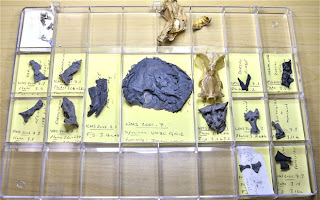Humans evolved from a prehistoric shark that roamed the seas more than 300 million years ago, say scientists.
The primitive fish named Acanthodes bronni was the common ancestor of all jawed vertebrates on Earth – including mankind, according to new research.
Acanthodes, a Greek word for "spiny", existed before the split between the earliest sharks and the first bony fishes – the lineage that would eventually include human beings.
Fossils have been found in Europe, North America and Australia.
Compared with other spiny sharks it was relatively large, measuring a foot long. It had gills instead of teeth, large eyes and lived on plankton.
Professor Michael Coates, a biologist at the University of Chicago, said: "Unexpectedly, Acanthodes turns out to be the best view we have of conditions in the last common ancestor of bony fishes and sharks.
"Our work is telling us the earliest bony fishes looked pretty much like sharks, and not vice versa. What we might think of as shark space is, in fact, general modern jawed vertebrate space."
Cartilaginous fish, which today include sharks, rays, and ratfish, diverged from the bony fishes more than 420 million years ago. But little is known about what the last common ancestor of humans, manta rays and great white sharks looked like.
The acanthodians died out about 250 million years ago and generally left behind only tiny scales and elaborate suits of fin spines.
But armed with new data on what the earliest sharks and bony fishes looked like, the researchers re-examined fossils of Acanthodes bronni, the best-preserved species.
A re-examination of a braincase dating back 290 million years shows it was an early member of the modern gnathostomes – meaning "jaw-mouths" that include tens of thousands of living vertebrates ranging from fish to birds, reptiles, mammals and humans.
Prof Coates said: "We want to explore braincases if possible, because they are exceptionally rich sources of anatomical information.
"They are much better than scales, teeth or fin spines, which, on their own, tend to deliver a confusing signal of evolutionary relationships."
The analysis of the sample combined with recent scans of skulls from early sharks and bony fishes led the researchers to a surprising reassessment of what Acanthodes bronni tells us about the history of jawed vertebrates.
Prof Coates said: "For the first time, we could look inside the head of Acanthodes, and describe it within this whole new context. The more we looked at it, the more similarities we found with sharks."
The study, published in Nature, found acanthodians as a whole, including the earliest members of humans' own deep evolutionary past, appear to cluster with ancient sharks.
This new revision of the lineage of early jawed vertebrates will allow paleontologists to dig into deeper mysteries, including how the body plan of these ancient species transformed over the transition from jawless to jawed fishes.
Added Prof Coates: "It helps to answer the basic question of what is primitive about a shark. And, at last, we are getting a better handle on primitive conditions for jawed vertebrates as a whole."
Environmental biologist Dr Maureen Kearney, of the National Science Foundation in the US which co-funded the research, said the study shows us "important evolutionary transitions in the history of life, providing a new window into the sequence of evolutionary changes during early vertebrate evolution".
Source Telegraph




